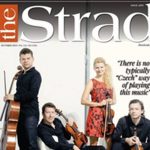The great variety of solutions offered by Guarneri ‘del Gesù’ in his late violins, among which this example stands out for its charm and well-preserved state, provoke conflicting reactions in the viewer: wonder at the beauty of the workmanship; curiosity at the seeming contradiction between the maker’s skill and intuition and his purported troubled state of mind at this time. What drove this innovative personality to create work that is at once existential and professionally finished will probably forever remain obscure. In Guarneri’s short career his output evolved from a classical Stradivarian approach seen in his first labelled instruments from the early 1730s into the wild, freewheeling, more expressionist style of his last years, exemplified by the exasperated nature of the carving and drawing, and the striking contrasts between some of the stylistic and organological features of his instruments. The change of direction both stylistically and functionally that took place in Guarneri’s making during his last period (1740–4) occurred soon after the death of Antonio Stradivari in 1737, an event that had a seismic impact on the remaining Cremonese violin makers. It marked the end of an era, and happened during a period of great change in Italian and European society and culture: the end of the Baroque period meant the curtailment of substantial commissions from rich aristocratic courts; Italy had once again become a battlefield where France and Austria were fighting for supremacy; in spite of military occupation, quality of life was improving in northern Italy; the cultural environment in Lombardy was sensitive to Enlightenment ideas; music no longer had solely an encomiastic and commemorative purpose; a new musical market was flourishing in Venice, Milan, Naples and other towns; and a new generation of professional musicians was seeking a stronger, richer sound. Such musicians probably counted among Guarneri’s customers – players who wanted to buy a violin as a straightforward sound machine: decorations were not necessary and a touch of freakishness was welcome.
Guarneri seems to have had a surprisingly pragmatic, even rationalist technical approach to violin making during this time. Although he disregarded the formal beauty of the traditional Cremonese style, he was extremely careful in carving archings, adjusting the thickness of plates and positioning f-holes, and he experimented with different stop lengths, string lengths and rib heights. He wasn’t the only violin maker in Italy experimenting with new solutions, but whereas most other makers were adapting Stainer’s models, Guarneri was going his own way. The search for a bigger, more modern sound is rooted in this period. In addition, as a result of the development of virtuoso violin technique, many makers were experimenting with neck configuration (length and inclination). In this sense Guarneri, for all his contradictions, was riding modernity, although he remained rooted in tradition: while exploring new possibilities regarding projection he was careful to retain features of classical Cremonese lutherie by employing an obsolete mould, using maplewood, applying an extraordinary varnish and – somewhat ironically – taking as his main inspiration the Brescian violin makers, one-time rivals of the Cremonese.
Provenance
According to Charles Beare’s certification this beautiful violin was made between 1742 and 1743. Nothing is known about its early history, and even information that might have been gathered in the 19th century is absent. The first known documentation is the certificate issued to Alfred A. Courbin of New York by J.&A. Beare in May 1932; a few months later the violin passed to another New Yorker, Leo Reisman, who bought it from Emil Herrmann. In 1953 the violin was sold by Rembert Wurlitzer to the collector Theodore Pitcairn, who lent it to the young Anshel Brusilow, principal violin of the Philadelphia Orchestra until 1966. Three years later, when Brusilow left the orchestra for a teaching post, it was sold by William Moennig to Phyllis Skoldberg, a violinist and director of the Arizona State University, who kept it until recent times when it was sold to the present owner.
Construction
Although missing the original neck-block and end-block and the linings of the upper treble rib, the interior looks well preserved and shows all the typical signs of the work of Guarneri ‘del Gesù’. Corner-blocks and linings are made of spruce (unlike Stradivari, Guarneri always preferred blocks of spruce rather than willow).The blocks show signs of splitting and some toolmarks, as do the linings, which – firmly mortised into the blocks – appear to have been bent and worked in haste. The maple of the ribs matches well with the back and was disposed without particular regard for the direction of the flames; the lower rib today is interrupted at the button by a restoration patch, but it seems likely that it once ran continuously form corner to corner. Deep marks produced by a coarse-toothed plane blade are visible on the interior rib surfaces, suggesting that this side of the wood was left almost uncleaned, and even on the outside a few toothed-plane marks are visible on the treble C-bout. The entire bending process was undertaken with both confidence and carelessness, the sides showing some cracking on the inside view of the C-bouts and some scars on the outside caused by the heat of the bending iron.
Only one centring pin has survived: made of a dark hardwood, it is set on the lower treble side of the back, quite far in, laying its centre about 6.5mm from the edge. It is about 2.5mm in diameter and was left slightly oval.
Plates and archings
The maple used for the back of the ‘Brusilow’ violin is of superb quality, showing a wide and deep flame and highly reflective luminosity. As in many other violins by this maker, the centre joint appears to have been rejoined several times, perhaps because fresh (instead of aged) wood was used. Arching is full and round: in the middle bouts it is 15.8mm high and it remains quite full up to the edges and continues all the way to the upper and lower extremities. Contrary to the usual care applied in the carving of his archings, Guarneri seems this time to have worked swiftly and carelessly: in the middle bout the back was worked along the grain, resulting in deep waves and hollows; in the upper and lower bouts also on the back, the connection of the edgework to the arching is also quite bumpy. In the interior of the back, no dorsal pin is present.
The belly of the violin is made of a fine Italian spruce of medium grain that becomes narrower towards the centre joint. The arching is 15.7mm high, with the highest point towards the upper side of the middle bout (just below the upper corner-blocks). There is a decrease of 0.5mm at the bridge, and from the arching profile it appears slightly in descent towards the lower block. Well rounded in the middle bout, the arching shows a nice Brescian inspiration: transversal curves in the upper and lower bouts are kept quite full, there is no channelling hollow curve, and it reaches the purfling straight and full. Workmanship on the front looks much more accurate than that on the back, with more respect for symmetry and toolmarks removed; only below the lower curves of the f-holes is the action of the scraper that raised the spruce grain still visible.
Edge-work
The most attractive feature of this gorgeous instrument is a kind of powerful three-dimensionality that hits the eyes and makes the viewer want to touch it lightly in order to scan its unpredictable surface. The edgework is emblematic: while delicately passing a finger over the surface one can feel how quickly, spontaneously and even roughly the scoop and its connection to the arching were carved. The small chips along the edgework clearly show that
the scoop was carved before the purfling channel was cut. The connection with the arching was worked in the direction of the grain and finished with vigorous strokes of the scraper,
creating a deeply waved surface. The fluting was finished after the insertion of the purfling into the channel with a small gouge that left a number of marks all along the contour; corners were cut with a small flat gouge – deeply in the upper corners of the back, and much more lightly in the belly. The rounding of the edge appears to have been undertaken mostly with a knife: the inner side that touches the ribs was rounded before gluing the back to the ribs and it presents some chips and knife marks. The edge contour itself was worked with a knife that left some flat areas that are visible as well as detectable through touch.
The edge thickness is well balanced though somewhat uneven, running from 3.0–3.2mm in the lower and upper bouts up to 3.7–4.2mm in the corners and C-bouts. The general look creates a sort of contrast between the spontaneous and fast carving of the scoop with the smooth rounding of the edges, giving to the edgework a balanced and even elegant appearance. Generally, the edgework of the back is of a stronger character while that of the belly is more delicate in appearance, owing to the softer wood and a slightly shallower scoop.
F-holes
Although bearing a subtle Brescian flavour, the f-holes look particularly mellow and well balanced, being quite different from, for example, the sharp and long cut of the 1743 ‘Carrodus’ Guarneri ‘del Gesù’ or the crude wildness of the 1744 ‘Doyen’. The typical late-period asymmetry between f-holes is less striking here, the overall look having a more classical feel. According to John Dilworth, Guarneri would centre the holes in relation to the edges rather than the centre line. In this violin the upper holes and the upper flanks appear to be nearly positioned on the centre line, with the bass hole opened slightly higher than the treble one. The lower end of the f-holes looks more asymmetrical in relation to both the centre line and the edges. F-hole cutting was undertaken with a free hand, with the gap between the upper wings and the curve very wide – the general look seeming to confirm that the maker, rather than respecting the line of a traced model, was following his eye and his own personal inspiration in a search for improvement to the sound. The lower part of each wing was left unscooped
The violin’s front is made from Italian spruce of medium grain that becomes narrower towards the centre joint and ends up quite full and round – an unusual feature in Guarneri’s work. The f-hole area shows the traces of an abrasive treatment undertaken before varnishing: all along the contour one can see a flat area and a sort of rounding around the hole that suggest a kind of sanding action that eliminated the sharp edge of the cut; the same feature can be seen in the ‘Cannon’ of 1743.
Scroll
A less figured but matching maple was used for the scroll, with an extra piece of wood joined to each side in order to reach a sufficient width. The front view still appears quite narrow, the width at the ears being slightly over 38mm, giving the sensation of a certain rigidity similar to – though slightly more delicate than – that of the ‘Cannon’ scroll. In the upper side of the pegbox a few cuts are visible from the saw blade that detached the head from the block, and the pegbox was carved nearly all the way up to the throat with a small curved gouge, which also left its marks at the upper end. The inner chamfer was cut with a chisel at a slanted angle; and the hollowing of the front of the volute was finished with a knife, with the end towards the throat left flat and unfinished. The central spine between the fluting shows no scribe lines and a few pin marks are visible; the centre line at the back, which looks well rounded, shows a few indentations from the hollowing work that was done with a gouge. All the carving on the scroll appears smoother than that of others of his scrolls from the same period and generally the toolmarks were removed with an efficient abrasive action.
The pegbox flanks were left quite flat and delicately smoothed on the outside. The cut of the turns begins dramatically from around the A-peghole, in quite a Brescian manner, and was done with a curved gouge. The turns were cut freehand, and if Guarneri used a template it would have been as a rough guideline only. From above, the turns look strongly off-centre. The pegbox chamfer was cut with a chisel with a flat angled direction; it is quite uneven, but was not as crudely cut as that of the ‘Cannon’, being slightly rounded. The eyes look particularly attractive, closing the turn with a sharp expressive cut. The chamfer of the scroll was painted with black ink, tracks of which are still visible in the eyes and throat.
Varnish
The varnish in late violins by Guarneri ‘del Gesù’ often differs in colour, texture and thickness. The varnish on this well-preserved violin was originally of soft texture, subtle thickness and a bright orange–brown colour, enhanced by Guarneri’s well-known ground with its reflective, multi-chromatic harmony. The craquelure – small-textured but quite deep – probably occurred when the violin was still quite young and was unfortunately flattened during aggressive restoration work. However, some of the original texture is still visible and can be admired especially in the hollows left during the carving of the arching.
The missing label
Like many violins by ‘del Gesù’, this one has lost its original label, although it is possible to describe the maker’s lael design and the meaning of the cross surmounting the trigraph ‘IHS’ (the first three letters of the name Jesus in the Greek alphabet). According to early 18th-century tradition, Giuseppe Guarneri was nicknamed ‘del Gesù’ to differentiate him clearly from Giuseppe ‘filius Andreae’, and the name came from the Christian insignia on his labels. Consequently people associated ‘del Gesù’ with the Jesuits, from whose patronage he was believed to be benefiting owing to commissions he was getting from wealthy families. But it seems unlikely that he was, because dance, music and other such worldly activities were strictly forbidden in the Cremonese Jesuitical circle. Furthermore, the symbol used by the Jesuits differs from Guarneri’s, being a Latin cross (with the horizontal arm shorter than the vertical one) placed within a radiant sun and intersecting the ‘H’ with three nails arranged beneath, recalling the Passion of Christ. A similar symbol to the Jesuits’ one, though lacking nails, was common in Cremona from the Renaissance and is related to the Franciscan friar Bernardino da Siena, who, according to researcher Andrea Foglia, was in town in 1435 for a long period of preaching. During his speeches the friar would display the holy insignia within a radiant sun surrounded by a cord, and this symbol was subsequently produced in marble, wood and earthenware and was set on the front doors of numerous buildings to protect against evil. It was also used as a trademark by Cremonese merchants, craftsmen and printers throughout the 16th and 17th centuries.
In 1731, Guarneri ‘del Gesù’ was back living and working in Cremona, having abandoned the old Guarneri house to start his own career in a new home. He began marking his violins with a new label, one that recalled the city’s old tradition: a bare Christological trigraph surmounted by a graceful, lobated Greek cross.
Copyright © 2015 Alberto Giordano, The Strad magazine – All rights reserved





